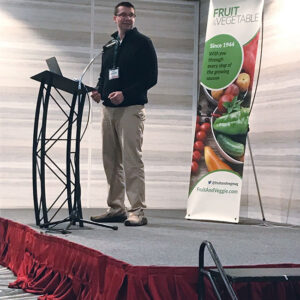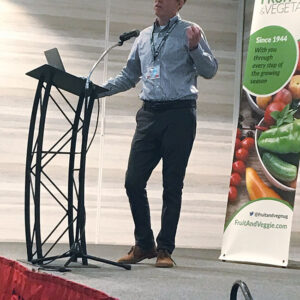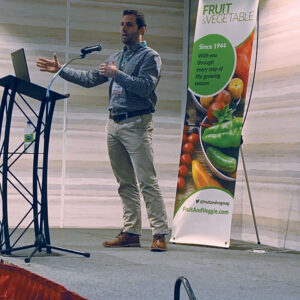
Features
Soil
Growing soil management know-how
The inaugural Canadian Fruit & Vegetable Summit dug into soil topics and laid the groundwork for future events.
January 31, 2024 By Alex Barnard
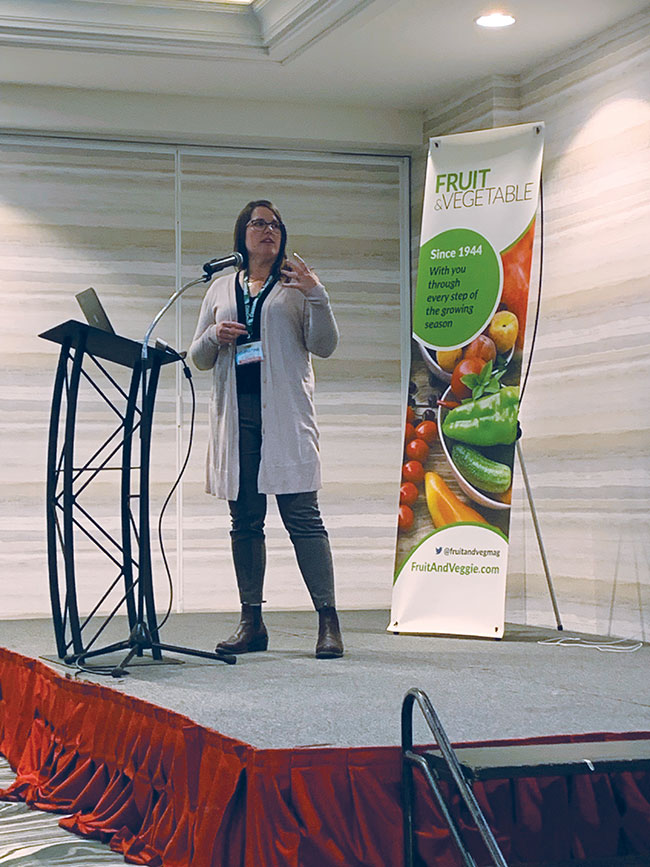 Niagara College's Christine George shares her expertise on soil
amendment trials with attendees.
All photos by Fruit & Vegetable.
Niagara College's Christine George shares her expertise on soil
amendment trials with attendees.
All photos by Fruit & Vegetable. The weather outside may have been frightful thanks to the season’s first major snowfall for the region icing roads and disrupting traffic, but the atmosphere inside the inaugural in-person Canadian Fruit & Vegetable Summit was truly delightful. On Nov. 29, attendees and exhibitors joined Fruit & Vegetable in St. Catharines, Ont., for a day of presentations and discussion around the summit’s theme of “Breaking ground in soil and water.”
Soil health and testing
The day kicked off with a presentation from Jason Henry, a senior research scientist at Vineland Research and Innovation Centre in Vineland, Ont. He recently established the Soil Health and Substrate Quality Assessment Laboratory at Vineland and acts as the lab’s supervisor. Henry’s talk focused on the building blocks of soil health, looking at the physical, biological and chemical properties that encompass healthy soil. According to Henry, sniffing your soil is one quick way to gauge its health – if it stinks, the soil microbial community is in dire straits and needs a little TLC.
Danny Jefferies of the Ontario Ministry of Agriculture, Food and Rural Affairs (OMAFRA) was on hand to discuss soil health metrics. Jefferies was hired this summer as the new soil management specialist, horticulture, following the retirement of 35-year OMAFRA veteran and soil health stalwart Anne Verhallen. The focus of Jefferies’ presentation was on soil testing and methods or rubrics for examining soil – particularly the soil health assessment and plan (SHAP), created by OMAFRA.
Both Henry and Jefferies highlighted the importance of aggregate stability, or how well soil aggregates stay together. This encompasses the building blocks of good soil structure: higher porosity, improved filtration, gas exchange, as well as less runoff and erosion.
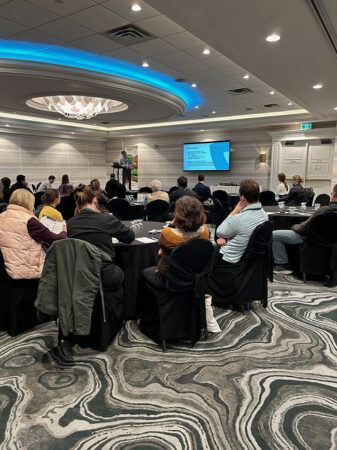
Researchers, growers and industry representatives enjoyed fruitful conversations at the inaugural Canadian Fruit & Vegetable Summit.
Innovation in the field
Covering research on soil amendments was Christine George, research lead for the Horticultural & Environmental Sciences Innovation Centre (HESIC) at Niagara College.
In addition to discussing trials she has conducted with biochar and zeolite (heavier than perlite), George noted upcoming field trials will look at these amendments in an outdoor horticulture context.
She also explained the five different Innovation Centres housed at Niagara College and the work they do, as well as the potential for growers and industry to partner with the centres for improving operational efficiencies, product development and marketing, and general business tips.
Sonny Murray, berry specialist with Perennia Food and Agriculture in Nova Scotia, joined the summit via Zoom to present on weed management strategies in June-bearing strawberries.
Murray dug into the nitty-gritty of spray programs and chemical management options that work together to control weeds in strawberry crops most effectively. He flagged wood sorrel as a weed to keep an eye on due to its growing prevalence. Murray also emphasized the importance of having a playbook for weed management so you can track timing and revisit the plan if it needs tweaking.
Keeping soil grounded
Kevin McKague has worked with OMAFRA for almost 25 years – 21 of which have been as a water quality engineer. That depth of experience in research and extension work were apparent in his presentation on soil erosion. In addition to the types of erosion and the effects of erosion on a field and the environment more broadly, McKague also covered erosion prevention and management strategies. While specific management tactics depend on the individual field’s features and history, McKague offered agronomic and structural controls for growers to consider.
Near the end of the day, the four speakers physically present for the summit took the stage to answer a few bigger-picture questions. On the topic of which nutrient they would like to see growers give more attention, Jefferies responded with magnesium, Henry said nitrogen, George answered sulphur, and McKague took a slightly different tack, noting the importance of water – no water, no crop.
Alongside these presentations were more informal chats between researchers, growers and industry representatives – the kind of fruitful conversations best had when getting together to talk shop.
What’s next?
The Canadian Fruit & Vegetable Summit will return in 2024. Are there topics or practices you’d like to see covered at future summits? Feel free to send us your thoughts at fruitveg@annexweb.com. We’d love to hear from you.
Editor’s note: Mark Richards of Richards Rolling Acres in Chatham-Kent, Ont., was unable to give a presentation on how he manages soil health on his farm as planned.
Print this page
